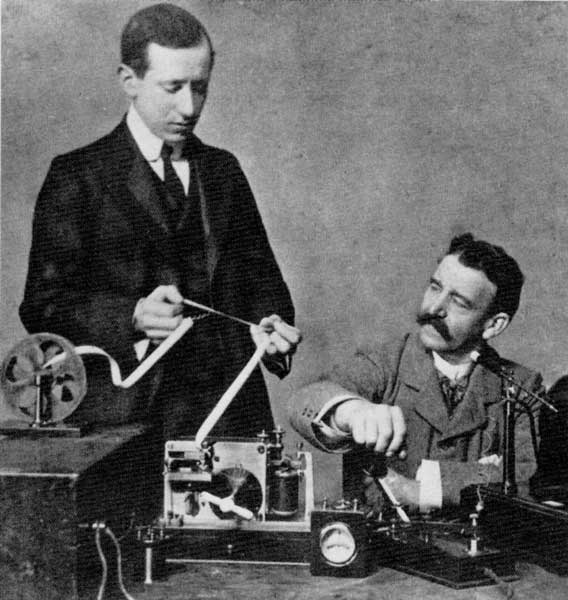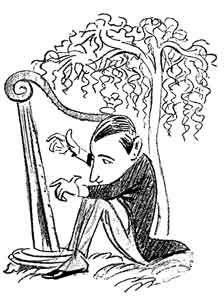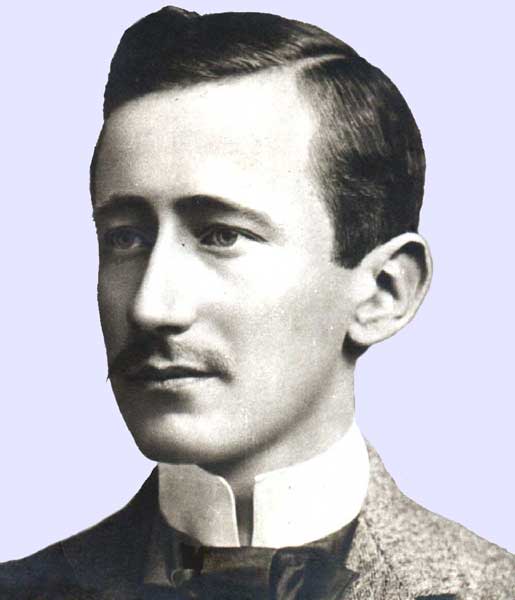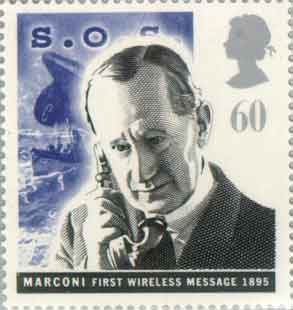Guglielmo Marconi, GCVO (25 April 1874 – 20 July 1937) was an Italian electrical engineer and Nobel laureate, known for the development of a practical wireless telegraphy system commonly known as the "radio". Marconi was President of the Accademia d'Italia and a member of the Fascist Grand Council of Italy.
Background
Marconi was born near to Bologna, Italy, the second son of Giuseppe Marconi, an Italian landowner, and his Irish wife, Annie Jameson, granddaughter of the founder of the Jameson & Sons Distillery on 25 April 1874. He was educated in Florence and, later, in Livorno.
Middle years
Although many scientists and inventors contributed to the invention of wireless telegraphy, including Oliver Lodge, Hans Christian Ørsted, Michael Faraday, Heinrich Rudolf Hertz, Jagadis Chandra Bose, Alexander Popov, Nikola Tesla, Thomas Alva Edison, Nathan Stubblefield, and others, Marconi's practical system achieved widespread use, so he is often credited as the "father of radio." Marconi's system was based primarily on Nikola Tesla's system, theoretically demonstrated during a widely known lecture titled On Light and Other High Frequency Phenomena, presented before a meeting of the National Electric Light Association in St. Louis and the Franklin Institute in Philadelphia.
Marconi sent radio signals of 300 meters (and up to 6 Kilometers) on Salisbury Plain (England) in 1896. Marconi was awarded the patent for Radio with British Patent GB12039, "Improvements in transmitting electrical impulses and signals and in apparatus there-for" on 2 July 1897 (sometimes recognised as the World's first patent). In July 1897, Marconi formed the London based Wireless Telegraph Trading Signal Company (later renamed the Marconi Wireless Telegraph Company), which opened the World's first "wireless" factory in Hall Street, Chelmsford, England in 1898, employing around 50 people.
Marconi made the first wireless transmission across water May 13th 1897, from Lavernock Point, South Wales to Flat holm Island. He made a wireless transmission across the water from Ballycastle (Northern Ireland) to Rathlin Island in 1898. He received the first trans-Atlantic radio signal on 12 December 1901 at Signal Hill in St John's, Newfoundland (now in Canada) using a 400-foot kite-supported antenna for reception.
This was surprising at the time as it was thought by the mainstream that a radio signal could only be transmitted in the line of sight. The transmitting station in Poldhu, Cornwall used a spark-gap transmitter to produce a signal with a frequency of approximately 500kHz and a power of 100 times more than any radio signal previously produced (a maximum time-averaged power of 35 kilowatts, but with a peak pulse power of several tens of megawatts [1]). The message received was three dots, the Morse code for the letter S. To reach Newfoundland the signal would have to bounce off the ionosphere twice. Dr Jack Belrose has recently contested this, however, based on theoretical work as well as an actual reenactment of the experiment; he believes that Marconi heard only random atmospheric noise and mistook it for the signal. However there is little doubt that by February 1902, Marconi's apparatus was fairly reliably receiving complete messages at 2500 km (1550 miles) at night and 1100 km (700 miles) by day, and usually picked up a special test signal at 3400 km (2100 miles), the distance of Poldhu to Newfoundland. By 1903, the Marconi Company was carrying regular transatlantic news transmissions.
On 16 March 1905 he married Beatrice O'Brien, daughter of Edward Donough O'Brien, 14th Baron Inchiquin, Ireland. They had three daughters, one of whom lived only a few weeks, and one son. They divorced later. Marconi did not achieve fully reliable transatlantic communication until 1907.
He was the founder of the Marconi Corporation and the joint 1909 recipient of the Nobel Prize in Physics along with Karl Ferdinand Braun. During World War I, Marconi was in charge of the Italian wireless service. Marconi developed shortwave secret communication transmissions during this time.
Later years

Marconi and George Kemp
In 1901, Marconi built a station near Wellfleet, MA. It was first called CC (Cape Cod), then MCC (Marconi Cape Cod) and finally WCC when the US government issued "W" call letters to stations east of the Mississippi. In 1903, from this station, Marconi sent the famous message from the President of the US to the King of England. This message was sent directly from Welfleet to England,without being relayed via Glace Bay, Nova Scotia (Which was another Marconi station). During WWI, all radio stations went off the air. When the war was over, Marconi had planned to move the station to Chatham. This was mainly because the ocean had eroded the cliff where the Welfleet station stood. Reportedly, the U.S. Government was worried about foreign ownership of radio stations.
Marconi was forced to sell all his interests in the US to the RCA Corp. WCC remained for several years, was sold to MCI and was finally shut down. In 1911, Marconi receives the patent GB13020, "Installations for wireless telegraphy". In 1914 Marconi built Chatham Radio WCC in Chatham Cape Cod, which would become the busiest ship to shore radio station for most of the twentieth century.
In 1920 Marconi's Chelmsford factory was the location of the first officially publicised sound broadcasts in the UK, one of them featuring Dame Nellie Melba. In 1922 the World's first regular wireless broadcasts for entertainment commenced from the Marconi Research Centre at Writtle near Chelmsford. Marconi joined the Italian fascist party in 1923. Benito Mussolini made Marconi President of the Accademia d'Italia, which also made him a member of the Fascist Grand Council. He made fascist speeches on the radio in a number of countries.
On 15 June 1927 he married Maria Cristina Bezzi-Scali; Mussolini was best man. Their daughter was named Maria Elettra Elena Anna Marconi. Marconi died in Rome on 20 July 1937.
Who invented the radio?
Marconi's claim that he invented radio was always disputed by Nikola Tesla and Alexander Popov.
Marconi did develop a practical model and was responsible for the first successful exploitation of the invention practically at the same time with Alexander Popov, who described his findings in a paper published in 1895. Popov publicly demonstrated the transmission of radio waves between different campus buildings to the St Petersburg Physical Society in March 1896. Actually, Marconi publicly demonstrated his system several months later, in September. Upon learning about Marconi's experiments, Popov effected ship-to-shore communication over a distance of 6 miles in 1898 and 30 miles in 1899. He died in 1905 and his claim was not pressed by the Russian government until 40 years later.
Tesla initially held the rights to radio, but the US Patent Office reversed its decision and awarded Marconi the patent for radio. Tesla fought to re-acquire his radio patent. A lawsuit regarding this was resolved by American courts in Tesla's favor (1943). This decision was based on the fact that there was prior work existing before the establishment of Marconi's patent (developed by Tesla). At the time, the United States Army was involved in a patent infringement lawsuit with Marconi's company regarding radio, leading some to posit that the government granted Tesla the patent on order to nullify any claims Marconi would have to compensation (as, some posit, the government's initial reversal to grant Marconi the patent right in order to nullify any claims Tesla had for compensation).
Another pioneer of wireless communication was Prof Jagdish Bose. In 1894, Bose ignited gunpowder and rang a bell at a distance using electromagnetic waves, confirming that communication signals can be sent without using wires.
Patents
See also
H. J. Round

I like Marconi best to see
Beneath a Macaroni tree
Playing that Nocturne in F Sharp
By Chopin, on a Wireless Harp.
Confessions of a Caricaturist, by Oliver Herford
Links and resources
- Guglielmo Marconi documentary narrated by Walter Cronkite
- Nobel : Guglielmo Marconi - Biography
- Marconi Corporation's Marconi Calling
- Guglielmo Marconi
Radio
- Who started the electronic era?
- PBS : Marconi and Tesla: Who invented radio?
- The Guglielmo Marconi Case Who is the True Inventor of Radio
- U.S. Supreme Court, "Marconi Wireless Telegraph co. of America v. United States". 320 U.S. 1. Nos. 369, 373. Argued April 9-12, 1943. Decided June 21, 1943.
- 21st Century Books : Priority in the Invention of Radio - Tesla vs. Marconi
- BBC Reference to his first transmission over water [2]





